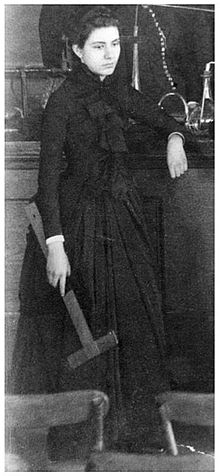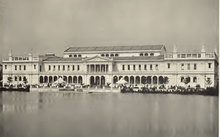Sophia Hayden
Sophia Hayden Bennett | |
|---|---|
 | |
| Born | October 17, 1868 |
| Died | February 3, 1953 |
| Alma mater | MIT |
| Known for | Woman's Building at the World's Columbian Exposition in 1892 |
| Scientific career | |
| Fields | Architecture |
Sophia Hayden Bennett (October 17, 1868 – February 3, 1953) was the first female graduate of the four-year program[1] in architecture at Massachusetts Institute of Technology.[2][3][4]
Life and career
Early life
Bennett was born Sophia Gregoria Hayden[1] in Santiago, Chile. Her mother, Elezena Fernandez, was from Peru, and her father, George Henry Hayden, was an American dentist from Boston.[5] Bennet had a sister and two brothers.[6] When she was six she was sent to Jamaica Plain, a suburb of Boston, to live with her paternal grandparents, George and Sophia Hayden, and attended the Hillside School. While attending West Roxbury High School (1883–1886) she found an interest for architecture. After graduation Bennett's family moved to Richmond, Virginia, but she returned to Boston for college.[1]: 94 She graduated from MIT in 1890 with a degree in architecture, with honors.
Education

Bennett shared a drafting room with Lois Lilley Howe,[7] a fellow female architect at MIT.[8] Bennett's work was influenced by MIT professor, Eugène Létang, featuring "Italian Renaissance detailing, straight-forward massing...[making] use of projecting pavilions and skylights."[3]
After completing her studies Hayden may have had a hard time finding an entry level apprentice position as an architect because she was a woman so she accepted a position as a mechanical drawing teacher at a Boston high school.[2]
Career

World's Columbian Exposition
She is best known for designing the Woman's Building at the World's Columbian Exposition in 1892, designing the building when she was just 21.[2][9] The Woman's Building was the nation's most prominent design competition for women at that time. Bennett based her design on her thesis project, "Renaissance Museum of Fine Arts."[1]: 94
Bennett's entry won first prize out of a field of thirteen entries all "submitted by women who considered themselves either specially trained in architecture or 'in the profession of architecture.'"[1]: 94 The Woman's Building was "a three-story, white building in the Italian Renaissance-Revival style with arches and columned terraces."[10] She received $1,000 at the time for the design, when male architects earned $10,000 for similar buildings.[11]
Of the many buildings designed by former MIT students, the Woman's Building was quite significant in that all aspects of the building were planned by women. While the design of the building was not unusual for its time, the concept was. The Board of Lady Managers, headed by Mrs. Potter Palmer, not only held a competition and designated their architect, but women artists and artisans also carried out the decorative program, with notable artists like Mary Cassatt responsible for the murals.
— MIT Museum Online Gallery[3]
During construction, Hayden's design principles were compromised by incessant changes demanded by the construction committee, spearheaded by socialite Bertha Palmer, who eventually fired Bennett from the project.[2][10] Bennett appeared at the Inaugural Celebration and had published accounts of support by her fellow architects.[12]
Her frustration eventually was pointed to as typifying women's unfitness for supervising construction, although many architects sympathized with her position and defended her. In the end the rifts were made up, perhaps, and Hayden's building received an award for "Delicacy or style, artistic taste, and geniality and elegance of the interior." Within a year or two, virtually all the Fair buildings were destroyed. Frustrated with the way she had been treated, Hayden may or may not have decided to retire from architecture, but she did not work again as an architect.[2]
Retirement
In 1900, Bennett married a portrait painter and, later, interior designer, William Blackstone Bennett, in Winthrop, Massachusetts. A stepdaughter, Jennie "Minnie" May Bennett, was from William Blackstone Bennett's prior marriage. The couple had no children. William died of pneumonia on April 11, 1909.[5]
Although Bennett designed a memorial for women's clubs in the U.S. in 1894, it was never built.[6] She worked as an artist for years and lived a quiet life in Winthrop, Massachusetts. Bennett died at the Winthrop Convalescent Nursing Home in 1953 of pneumonia after suffering a stroke.[2][6]
Works or publications
- "Abstract of Thesis: Sophia G. Hayden, 1890." Technology Architectural Review 3 (September 31, 1890): 28,30.
- "The Woman's Building." In Rand McNally and Company's A Week at the Fair, 180. Chicago: Rand McNally, 1893.
See also
Citations
- ^ a b c d e Sarah Allaback (2008). The First American Women Architects. University of Illinois Press. pp. 94–96. ISBN 978-0-252-03321-6.
- ^ a b c d e f Marter, Joan (2010). The Grove encyclopedia of American art. Oxford: Oxford University Press. ISBN 0195335791.
- ^ a b c "Sophia Hayden Bennett (1868-1953)" (Online exhibition). MIT Museum Online Gallery. From Louis Sullivan to SOM: Boston Grads Go to Chicago. Massachusetts Institute of Technology. 1996. Retrieved 15 October 2013.
- ^ "Sophia Hayden (later Bennett)". Cambridge Women's Heritage Project. December 2012. Retrieved 15 October 2013.
- ^ a b Boumenot, Diane (October 9, 2011). "Remembering Sophia Hayden Bennett, Part 1" (Online family history). One Rhode Island Family: My Genealogical Adventures through 400 Years of Family History. Retrieved 15 October 2013.
- ^ a b c Hayden, Dolores (1980). "HAYDEN, Sophia Gregoria, Oct. 17, 1868-Feb. 3, 1953". Notable American Women: The Modern Period (Web) (Credo Reference ed.). Cambridge: Harvard University Press. ISBN 9780674627345. Retrieved 16 October 2013.
- ^ "Lois Lilley Howe". Cambridge Women's Heritage Project. December 2012. Retrieved 15 October 2013.
In 1893 she submitted an application, on Allen and Kenway letterhead with a recommendation from Robert Peabody, to build the Woman's Building at the 1893 Chicago World's Fair. Her former MIT classmate Sophia Hayden also entered the competition. Hayden won and Howe placed second.
- ^ Bois, Danuta (1998). "Sophia Hayden (1868-1953)" (Online compendium of biographies). Distinguished Women of Past and Present. Retrieved 15 October 2013.
- ^ World's Columbian Exhibition, at Chicago,1492-1893-1892 (Book). Portland, Me: Chisholm Bros. 1893. Retrieved 16 October 2013.
- ^ a b Beasley, Soodie (February 3, 2010). "Women in Design: Sophia Hayden (1868 - 1953)". Soodie Beasley (blog). Retrieved 16 October 2013.
- ^ "IAWA database information for Sophia Hayden". International Archive of Women in Architecture (Biographical Database). University Libraries, Virginia Tech. 8 November 2003. Retrieved 15 October 2013.
- ^ The American Architect and Building News. Boston: James R. Osgood & Co. 1876. Retrieved 16 October 2013.
Further reading
- Allaback, Sarah; The First American Women Architects, Urbana: University of Illinois Press, 2008. p. 94-96. ISBN 978-0-252-03321-6.
- Ashby, Ruth, and Deborah G. Ohrn. "Sophia Hayden." Herstory: Women Who Changed the World. New York: Viking, 1995. ISBN 978-0-670-85434-9.
- Darney, Virginia Grant, Women and World's Fairs: American International Expositions, 1876-1904. Ann Arbor, Mich: UMI Dissertation Services, 1982. OCLC 224428837
- Gullet, Gayle. "Our Great Opportunity": Organized Women Advance Women's Work at the World's Columbian Exposition of 1893. Illinois Historical Journal (Winter 1994). PDF edition. Illinois State Historical Society. OCLC 40058087.
- Hayden, William B. In Memoriam: Mrs. Sophia W. Hayden, 1819-1892. Boston: Massachusetts New-Church Union Press, 1893. Print. OCLC 146403030.
- Larson, Erik; The Devil in the White City: Murder, Magic, and Madness at the Fair That Changed America, Crown Publishers, 2003. ISBN 978-0-609-60844-9.
- Sicherman, Barbara, and Carol H. Green. “Hayden, Sophia Gregoria.” In Notable American Women: The Modern Period : a Biographical Dictionary. Cambridge, Mass: Belknap Press of Harvard University Press, 1980. ISBN 978-0-674-62733-8.
- Stern, Madeleine B. "Three American women firsts in architecture: Harriet Irwin, Louise Bethune, Sophia G. Hayden Science & technology : America's first woman telegrapher: Sarah G. Bagley." We the Women: Career Firsts of Nineteenth-Century America. New York: Schulte Pub. Co, 1963. OCLC 382962
- Torre, Susana. "Sophia Hayden and the Woman's Building Competition / Judith Paine,"Women in American Architecture: A Historic and Contemporary Perspective : a Publication and Exhibition Organized by the Architectural League of New York Through Its Archive of Women in Architecture. New York: Whitney Library of Design, 1977. ISBN 978-0-823-07485-3.
- Weimann, Jeanne M. The Fair Women: the Story of the Woman's Building, World's Columbian Exposition, Chicago 1893. Chicago, Ill: Academy Chicago, 1981. ISBN 978-0-897-33025-1.
Online Resource - Photo Source
- Alden, Henry M. Harper's New Monthly Magazine. New York: Harper & Bros, 1850. Internet resource. OCLC 1641392 Sophia G. Hayden at Hathi Trust.
External links
- Remembering Sophia Hayden Bennett - detailed biography with references
